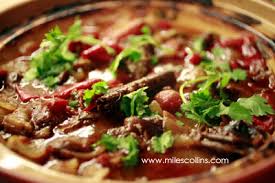
Move over, Dutch stove. There another moderate cooker making high temperature waves in the kitchen, and it has all that you'd need from a take-your-time strategy: basic one-pot flavor in a conelike vessel that looks as at home on a smooth presentation retire as inside the broiler.
The tagine, an earth pot for cooking North African stews (additionally called tagines) may not be well known to the normal American cook, however its been utilized for quite some time as a part of Morocco. The dishes it creates, initially devised by local Berber tribes, frequently comprise of delicate chicken, sheep, fish and vegetables in rich sauces and flavors. The funnel shaped top permits steam to climb and gradually fall as the stuff inside prepares.
The tagine, a mud pot for cooking North African stews (likewise called tagines) may not be recognizable to the normal American cook, however its been utilized for quite some time within Morocco. The dishes it delivers, initially devised by local Berber tribes, frequently comprise of delicate chicken, sheep, fish and vegetables in rich sauces and flavors. The funnel shaped top permits steam to climb and gradually fall as the stuff inside prepares.
"From the perspective of a cutting edge cook, [using a tagine] is a succulent method for cooking meat or vegetables," says Ghillie Basan, the Scotland-based creator of "Tagines and Couscous" (Ryland Peters & Small, 2010). "In the days of yore, tribal individuals utilized exceptionally intense cuts of meat, and it was a method for guaranteeing that it was delicate enough to consume."
In spite of the fact that tagine pots are eye-getting, you needn't bother with one to set up a tagine stew. Actually, brightening tagines with bright examples are regularly not legitimately "prepared" for immediate high temperature over a stovetop or in a stove, so do your examination before looking for one. Luckily, there's adaptability.
Indeed the culinary specialist at the Moroccan Embassy, Nazha Kasraoui, says she's utilized pots rather than tagines. "In the event that you take after the conventional steps [in a recipe] — you can't place everything in immediately — you'll get great results," Kasraoui says. Besides, the stew can just be exchanged to a sly tagine for an amazing presentation at the table.
Customary Moroccan stews frequently have a sweet or fiery kick, clear in chicken with protected lemon and olives, or sheep with dried apples and oranges. Garlic, cumin, nectar, protected lemon and matured spread called smen are regular elements, and give tagines the key kinds of "blazing, sweet and salty," Basan says.
Fish can additionally star in the stews. Casablanca offers the dish with salmon, however Moroccans utilize a mixed bag of entire fish and fish in tagines. "It joins all the kinds of Moroccan food," Labriny says. "It has all the fundamental parts of flavors, in addition to it has new tomatoes, which I love in my nourishment."
To develop the flavor in your tagine, stock up on North African zest blends, for example, searing, bean stew filled harissa glue; and ras-el-hanout, an impactful mix of herbs. On the off chance that you would prefer not to make your own particular blend, discover an exhibit of fiery flavors at Zamourispices.com.
"You wouldn't expect those two together," Labriny clarifies, "on the grounds that they each one have an unique taste. You would consume the tagine with bread, commonly," though couscous is regularly served on its own, after the tagine.
Bring convention with a grain of salt, be that as it may. "The mystery is dependably to taste and to have a smidgen of innovativeness" when preparing a Moroccan feast, Basan says. "There are no strict leads on what ought to go into your dish; that is the excellence of cooking in parts of the world where (accessible fixings) range from region to zone."
All things considered, stewing a tagine can take hours — a lot of time to stew over how to include your own particular uncommon
 RSS Feed
RSS Feed Twitter
Twitter
 05:31
05:31
 Unknown
Unknown

